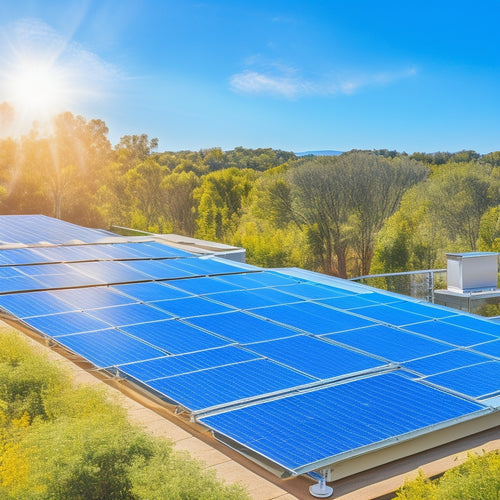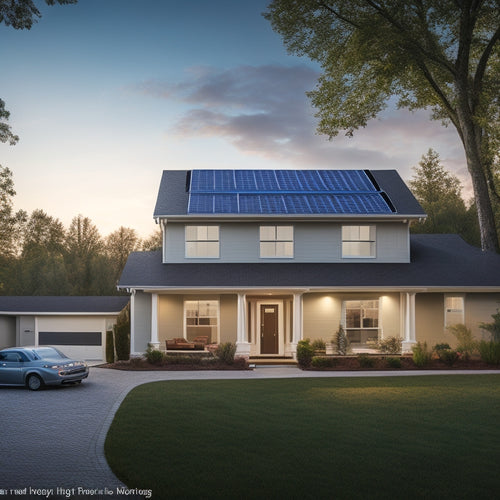
Off Grid Battery Pack
Share
You're looking to design a reliable off-grid battery pack that provides blackout protection and energy independence, and understanding its components, technologies, and maintenance practices is vital to achieving this goal. A well-designed off-grid battery pack serves as the backbone of your power system, providing essential power backup during blackouts and optimizing energy use from generated excess. To guarantee cost-efficient backup power, you'll need to take into account factors like battery safety, emergency preparedness, and compatible inverter management. Now that you've started building your off-grid power system, you're one step closer to revealing the full potential of renewable energy and reducing your reliance on fossil fuels.
The Essentials
- Off-grid battery packs provide reliable power backup during blackouts and enhance energy independence with solar integration.
- Deep cycle battery technology with high-quality units can last up to 20 years, with proper maintenance practices extending lifespan.
- Accurate calculation of daily energy needs and wattage is crucial for proper sizing of off-grid battery packs and ensuring seamless performance.
- Extended cycle life of up to 5,000 charge and discharge cycles can be achieved through advanced battery technologies and proper maintenance practices.
- Selecting compatible inverters and optimizing solar panel efficiency are essential for efficient energy harvesting and reduced fossil fuel reliance.
Reliable Power in Darkness
When the grid goes down, you need a reliable source of power to keep your essential systems running. A well-designed off-grid battery pack provides power blackout protection, ensuring your critical loads stay online even in darkness.
By integrating energy storage solutions, such as a deep cycle battery for solar, into your system, you can store excess energy generated during the day for use during nighttime or power outages, maximizing your energy independence renewable energy battery. This allows you to maintain a stable source of backup power during outages and increase your overall return on investment.
Power Blackout Protection
Power blackouts are a harsh reality in many parts of the world, leaving you in the dark and disrupting your daily routine. You need a reliable power backup system to guarantee your safety and comfort during these outages.
An off-grid battery pack with a solar backup can provide you with the energy independence you desire. By integrating a battery storage system into your solar setup, you'll reveal the full potential of renewable energy and create a more sustainable, dependable, and cost-effective power solution Energy Storage for Solar.
When designing your power blackout protection system, prioritize battery safety and emergency preparedness. Confirm your system is integrated with a compatible inverter to manage your loads efficiently. This will prevent overloading and reduce the risk of battery damage.
Regular maintenance is vital, so follow maintenance tips to extend the lifespan of your batteries. In the event of a blackout, your off-grid battery pack will restore power quickly, minimizing disruptions to your daily routine.
With a well-designed system, you can enjoy cost-efficient and reliable power, even in the dark. By integrating your off-grid battery pack with your solar backup, you'll have an all-encompassing power blackout protection system that guarantees your energy independence.
Energy Storage Solutions
With darkness descending, you need a reliable energy storage solution to keep your appliances running and your lights on. When the grid goes down, your off-grid battery pack becomes the backbone of your power system. You require an energy storage solution that seamlessly integrates with your solar array, guaranteeing a continuous flow of power.
With the rise of energy independence, homeowners are seeking innovative solutions to optimize their solar power systems Renewable Energy Storage, and an efficient battery pack is vital in this pursuit. Solar integration is essential, as it allows your battery pack to utilize excess energy generated during the day for use during the night or on cloudy days. This means your battery compatibility is paramount, as it guarantees a smooth changeover between solar power and stored energy.
When selecting an energy storage solution, consider the depth of discharge (DOD), round-trip efficiency, and cycle life. These factors directly impact the performance and lifespan of your battery pack. Look for solutions with high DOD and round-trip efficiency to maximize your energy storage capacity.
Additionally, opt for batteries with a long cycle life to minimize replacement costs and environmental waste. By choosing the right energy storage solution, you'll enjoy reliable power in darkness, and the freedom to live off-grid without compromise.
Increased Renewable Energy Output
You can considerably enhance your off-grid system's energy independence by increasing the renewable energy output. This is achieved through a higher energy harvesting rate, which allows you to collect more energy from your solar panels or wind turbines.
By integrating renewable energy systems with efficient power storage solutions, you can maximize your energy yield and reduce reliance on non-renewable sources.
Additionally, implementing off grid solar systems can further improve your energy independence. By pairing this with efficient power storage systems, you can maximize your energy yield and reduce reliance on non-renewable sources.
Higher Energy Harvesting Rate
Higher energy harvesting rates are vital for maximizing the output of off-grid renewable energy systems. You can achieve this by optimizing your solar panel efficiency and energy conversion techniques.
A higher energy harvesting rate means you'll generate more power from the same amount of sunlight, reducing your reliance on fossil fuels and increasing your energy independence.
To enhance your energy harvesting rate, consider using high-efficiency solar panels with lower temperature coefficients. These panels will perform better in hot climates and maintain their efficiency over time.
You can also implement advanced energy conversion techniques, such as maximum power point tracking (MPPT), to guarantee your system extracts the maximum amount of energy from the sun.
Efficient Power Storage Systems
Two key components of an off-grid renewable energy system are energy harvesting and power storage. When it comes to efficient power storage systems, you'll want to focus on maximizing energy efficiency while minimizing environmental impact.
To achieve this, consider a system that integrates seamlessly with your solar array, guaranteeing ideal solar integration.
Proper battery maintenance is vital to extend the lifespan of your batteries. You should also prioritize energy efficiency by selecting an inverter that matches your system's load management requirements. Charging methods, such as maximum power point tracking (MPPT), can also enhance energy efficiency.
As you scale up your system, confirm it's designed with safety features in mind, such as overcharge protection and short-circuit prevention.
Conduct a thorough cost analysis to determine the best system configuration for your needs and budget. By considering these factors, you'll be able to create an efficient power storage system that provides reliable renewable energy, giving you the freedom you desire.
Deep Cycle Battery Technology
When selecting a deep cycle battery for your off-grid system, you'll want to weigh two critical factors: battery life expectancy and cycle depth.
The lifespan of your battery will depend on the number of charge cycles it can handle, with higher-quality batteries offering more cycles before capacity drops. For instance, lithium-ion cells, commonly used in home energy storage systems, can provide up to 5,000 charge cycles renewable energy solutions.
Understanding how cycle depth affects your battery's performance will help you choose the right technology for your specific needs.
Battery Life Expectancy
You can expect a deep cycle battery to last for a certain number of charge and discharge cycles before its capacity starts to degrade. The lifespan of your off-grid battery pack greatly depends on how well you maintain it. Proper battery maintenance, such as regular checks on electrolyte levels, cleanliness, and secure connections, can greatly extend its life.
Moreover, the charging techniques you use also play an important role. Avoid overcharging or undercharging your batteries, as this can cause premature wear. It's vital to follow the manufacturer's recommended charging protocols to guarantee peak performance.
Typically, a deep cycle battery can last anywhere from 5 to 15 years, with some high-quality units lasting up to 20 years. However, this is heavily dependent on the quality of the battery and how well it's maintained.
Cycle Depth Matters
During daily use, the depth of discharge (DOD) greatly impacts the lifespan of your deep cycle battery. You need to understand that the more you drain your battery, the shorter its lifespan will be. A deeper cycle means you're using more of the battery's capacity, which reduces its overall lifespan.
For instance, if you regularly discharge your battery to 80% DOD, it will last considerably shorter than if you only discharge it to 50% DOD.
To maximize cycle efficiency, it's essential to implement effective battery management strategies. You can do this by monitoring your battery's state of charge (SOC) and adjusting your energy usage accordingly.
By keeping your battery's SOC between 20% and 80%, you'll reduce the number of deep cycles and extend its lifespan. Additionally, consider investing in a high-quality battery management system (BMS) that can detect and prevent over-discharging, over-charging, and other harmful conditions.
Count Your Daily Wattage
You need to calculate your daily energy needs to determine the right off-grid battery pack size for your system.
To do this, you'll want to tally up the total wattage of all your appliances and devices, taking into account both their power ratings and how many hours a day they'll be in use.
When designing your off-grid system, it's crucial to reflect on renewable energy solutions that can maximize energy harvesting and reduce blackouts.
Daily Energy Needs
The first step in designing an off-grid battery pack is to determine your daily energy needs, which involves calculating your daily wattage. This calculation is essential to make sure your energy storage system can meet your power requirements.
To do this, you'll need to assess your energy consumption habits, including the devices you use, their power ratings, and how often you use them. Start by making a list of all the appliances, lights, and devices you plan to power with your off-grid system.
Then, note their respective wattage ratings, usually found on the device or in the user manual. Calculate the total wattage by adding up the power requirements of each device.
Consider your solar panel integration and how it will impact your energy needs. For instance, if you have a solar panel array that can generate 500 watts of power, you'll want to make sure your daily energy needs don't exceed that amount.
Wattage Calculation Tips
To accurately calculate your daily wattage, it's essential to account for variables that impact energy consumption. You'll need to evaluate the devices you'll be powering, their wattage, and the number of hours they'll be in use. This will give you a clear overview of your energy needs.
| Device | Daily Wattage |
|---|---|
| Laptop | 65W x 4h = 260Wh |
| Refrigerator | 150W x 8h = 1200Wh |
| Lights | 20W x 8h = 160Wh |
| Total | 1620Wh |
When calculating your daily wattage, don't forget to factor in the efficiency of your solar panel integration and battery management system. These systems can affect the overall energy output and storage capacity of your off-grid battery pack. For example, if your solar panel integration has an efficiency rating of 90%, you'll need to adjust your calculations accordingly. By accurately calculating your daily wattage, you'll be able to size your off-grid battery pack correctly, ensuring you have the energy you need to live freely off the grid.
Longer Lifespan Guarantee
You're looking for an off-grid battery pack that lasts, and a longer lifespan guarantee is key.
With an extended cycle life, you can expect your battery pack to support up to 5,000 charge and discharge cycles.
This means you'll get a longer lifespan and reduced maintenance costs over time.
Extended Cycle Life
One essential aspect of an off-grid battery pack is its extended cycle life, which directly impacts its overall lifespan guarantee. You want a battery pack that can withstand the demands of off-grid living, and an extended cycle life guarantees you get the most out of your investment.
This feature is vital, as it determines how many charge and discharge cycles your battery can handle before its capacity starts to degrade.
When shopping for an off-grid battery pack, look for ones with advanced battery technology advancements that enable longer cycle life. These advancements often involve improved materials, designs, and manufacturing processes that reduce wear and tear on the battery.
Additionally, proper battery maintenance tips, such as avoiding deep discharges, keeping the battery at room temperature, and monitoring its state of charge, can also help prolong its cycle life.
Frequently Asked Questions
Can I Use an Off-Grid Battery Pack With a Generator?
When you're considering using a generator, you'll want to guarantee compatibility with your battery setup, as it affects overall efficiency; fortunately, many modern batteries are designed to work seamlessly with generators, allowing you to maximize energy storage and freedom.
How Long Does It Take to Fully Charge an Off-Grid Battery?
You'll wait an eternity - okay, not quite, but it feels like it! Seriously, the charging time depends on essential factors like battery capacity and charging power; for instance, a 10kWh battery takes around 5-10 hours to fully charge with a 2kW charger.
Are Off-Grid Battery Packs Recyclable at the End of Life?
When you're done with a battery, you'll want to know it's recyclable. Luckily, most battery compositions can be recycled using established processes. You'll be free to choose a responsible recycling method that recovers precious materials, minimizing waste and environmental impact.
Can I Install an Off-Grid Battery Pack Myself?
Ah, you think you're a Renaissance person, don't you? DIY installation sounds like a breeze, but hold on, cowboy! Safety considerations are no joke. You'll need to verify correct wiring, voltage regulation, and thermal monitoring to avoid a battery blaze.
Are Off-Grid Battery Packs Compatible With All Solar Panels?
When selecting solar panels, you'll find that many are compatible with various battery technologies, thanks to advancements in battery tech. However, you'll still need to verify the specific panel and battery chemistry you choose are compatible for peak performance and energy freedom.
Final Thoughts
You're about to access the full potential of your off-grid system with a reliable battery pack that stores excess energy, maximizes renewable output, and guarantees a longer lifespan. With deep cycle technology, you'll utilize every watt, hour by hour. Count your daily wattage with confidence, knowing your pack will perform consistently. Experience the freedom of independence from the grid, where power outages are a thing of the past, and energy self-sufficiency is a reality.
Related Posts
-

What Types of Solar Energy Devices Are Available
You'll find several types of solar energy devices available today, each customized to different energy needs. Photovo...
-

Cost of Solar With Battery Backup
You're investing in a solar panel system with battery backup to guarantee reliable power during outages. The cost of ...
-

Commercial Solar Energy
As you consider powering your business with commercial solar energy, you'll uncover it offers a triple benefit: signi...


